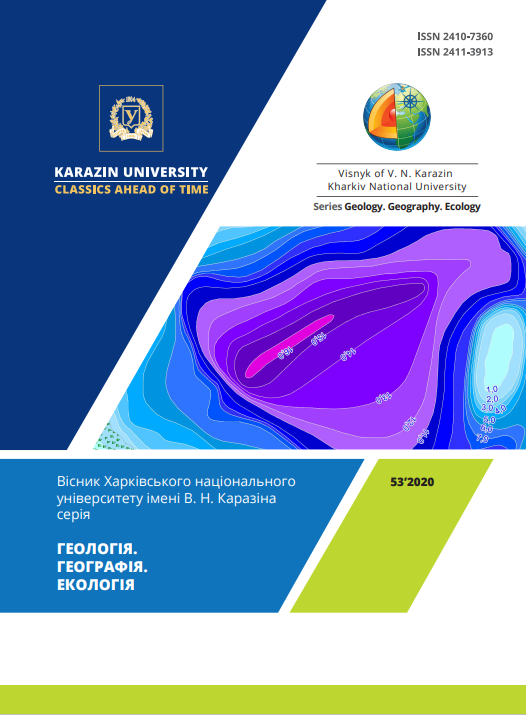Форма кумулятивного розподілу площ систем землекористування як параметр антропогенного впливу на ландшафти
Анотація
Удосконалення інструментарію змістового, інформаційного та розрахункового оцінювання впливу людської діяльності на довкілля є наразі вельми актуальною проблемою, зважаючи на необхідність збереження і відновлення біотичного та ландшафтного різноманіття. З огляду на таке в статті обґрунтовано та сконструйовано класифікаційну схему кумулятивного розподілу площ систем землекористування та/або його наслідків у ландшафтах і/або фізико-географічних таксонах як аналітичний інструментарій моделювання антропогенного впливу на них. Схема базується на ідеї адекватності типів зазначеного розподілу за його формою певній категорії та інтенсивності антропогенного впливу на ландшафти чи таксони. Власне розподіл площ систем землекористування типізовано за діапазонами параметра поліноміальних трендів кумулят зазначених площ у ландшафтах або їхніх агрегаціях. За таких умов схема кумулятивного розподілу площ оперує десятьма типами розподілу ̶ від надзвичайно опуклого до надзвичайно угнутого. Ці типи й віддзеркалюють різний антропогенний вплив на таксони ̶ від слабкого до надзвичайно сильного. Верифікацію схеми кумулятивного розподілу площ землекористувальних систем здійснено для тестового мегарегіону – 30 фізико-географічних областей і 130 фізико-географічних районів п'яти країв зон мішаних (хвойно-широколистяних) і широколистяних лісів і лісостепу України. Було змодельовано й проаналізовано відповідні цифрові картограми антропогенного впливу на зазначені таксони. Верифікація засвідчила валідність запропонованих нових методичних підходів і їхні переваги над моделюванням антропогенного впливу на ландшафти за допомогою середньовиважених і інших розрахункових індексів антропізації та схем. Розроблений модельний інструментарій та результати його верифікації застосовні для удосконалення методик, схем і проектів природоохоронного менеджменту рівнинних суходільних ландшафтів і їхніх агрегацій у помірних широтах.
Завантаження
Посилання
Samoilenko V., Plaskalnyi V. (2017). Modern procedure of landscape anthropization analysis. Problems of Geogra-phy, 1-2: 31-42. Sofia: Bulgarian Academy of Science, National Institute of Geophysics, Geodesy and Geography. Available at: http://geoproblems.eu/wp-content/uploads/2017/10/2017_12/2_samoilenko.pdf
Samoilenko V.M, Dibrova I.O., Plaskalnyi V.V. (2018). Anthropization of Landscapes. Monograph [in Ukrainian]. Kyiv: Nika-Center, 232. Available at: http://geo.univ.kiev.ua/images/doc_file/navch_lit/Antropizazia%20landchaftiv_ Samoylenko.pdf
Walz U., Stein C. (2014). Indicators of hemeroby for the monitoring of landscapes in Germany. Journal for Nature Conservation, 22: 279-289. Available at: http://dx.doi.org/10.1016/j.jnc.2014.01.007
IOER Monitor (2018). Monitor of Settlement and Open Space Development. Leibniz Institute of Ecological Urban and Regional Development.Web source: http://www.ioer-monitor.de
Winter S. (2012). Forest naturalness assessment as a component of biodiversity monitoring and conservation man-agement. Forestry, 85, 2: 293-304. Available at: https://doi.org/10.1093/forestry/cps004
Paracchini M.L., Capitani C. (2011). Implementation of a EU wide indicator for the rural-agrarian landscape. JRC scientific and technical reports (EUR 25114 EN-2011). Luxembourg: Publications Office of the European Union, 89. Available at: http://dx.doi.org/10.2788/25137
Eurostat Statistics (2012). Eurostat Statistics Explain: Agri-environmental indicator – landscape state and diversi-ty. Web source: http://ec.europa.eu/eurostat/statistics-explained
Csorba P., Szabó S. (2009). Degree of human transformation of landscapes: a case study from Hungary // Hungari-an Geographical Bulletin, 58. 2: 91-99. Available at: http://www.mtafki.hu/konyvtar/kiadv/HunGeoBull2009/ HunGeoBull_2009_2_91-99.pdf
Kiedrzynski M. et al. (2014). Historical Land Use, Actual Vegetation and the Hemeroby levels in ecological evalua-tion of an urban river valley in perspective of its rehabilitation plan. Pol. J. Environ. Stud., 23, 1: 109-117. Avail-able at: http://www.pjoes.com/Historical-Land-Use-Actual-Vegetation-r-nand-the-Hemeroby-Levels-in-Ecological-Evaluation,89173,0,2.html
Frank S. (2014). Development and Validation of a Landscape Metrics Based Approach for Standardized Land-scape Assessment Considering Spatial Patterns. Statement of the PhD Candidate. Technische Universität Dresden, 97. Available at: https://tud.qucosa.de/api/qucosa%3A28247/attachment/ATT-1/
Wrbka T. et al. (2004). Linking pattern and process in cultural landscapes. An empirical study based on spatially explicit indicators. Land Use Policy, 21(3): 289-306. Available at: https://doi.org/10.1016/j.landusepol.2003.10.012
Rüdisser J. et al. (2012). Distance to nature – A new biodiversity relevant environmental indicator set at the land-scape level. Ecological Indicators, 15: 208-216. Available at: https://doi.org/10.1016/j.ecolind.2011.09.027
Mercuri A.M., Florenzano A. (2019). The Long-Term Perspective of Human Impact on Landscape for Environmen-tal Change (LoTEC) and Sustainability: From Botany to the Interdisciplinary Approach. Sustainability, 11(2): 413-419. Available at: https://doi.org/10.3390/su11020413
Ellis E.C. et al. (2013). Used planet: a global history. Proceedings of the National Academy of Sciences of the USA, 110, 20: 7978-7985. Available at: https://dx.doi.org/10.1073%2Fpnas.1217241110
Guidelines for land use mapping in Australia: principles, procedures and definitions (2011). Australian Bureau of Agricultural and Resource Economics and Sciences. Fourth edition. Canberra: Commonwealth of Australia, 132. Available at: https://catalogue.nla.gov.au/Record/5739000
Shyshchenko P.G., Gavrylenko O.P. (2014). Geoecological rationale of environmental management projects. Text-book (el. version) [in Ukrainian]. Kyiv: Alterpress, 414.
Shyshchenko P.G., Gavrylenko O.P. (2015). Constructive-geographic bases of rational environmental management. Textbook (el. version) [in Ukrainian]. Kyiv: SE "Print Service", 395.
Grodzynskyi M.D. (2014). Landscape ecology. Textbook [in Ukrainian]. Kyiv: Znannia, 550.
Samoilenko V.M., Ivanok D.V. (2015). Modeling of basin geosystems. Monograph [in Ukrainian]. Kyiv: SE "Print Service", 208. Available at: http://geo.univ.kiev.ua/images/doc_file/navch_lit/Samojlenko_mod_bas.pdf
Kovalchuk, I., Mykytchyn, O., & Kovalchuk, A. (2019). Geoinformation modeling of anthropogenic transformation of the basin geosystems (case study of Dnister right tributaries). Visnyk of V. N. Karazin Kharkiv National Universi-ty, Series "Geology. Geography. Ecology", 51: 124-139. Available at: https://doi.org/10.26565/2410-7360-2019-51-09
Samoilenko V., Dibrova I. et al. (2018). Procedure of Landscape Anthropization Extent Modeling: Implementation for Ukrainian Physic-Geographic Taxons. Environmental Research, Engineering and Management, 74, 2: 67-81. Available at: http://dx.doi.org/10.5755/j01.erem.74.2.20646
Samoilenko V., Dibrova I. (2019). Geoecological Situation in Land Use. Environmental Research, Engineering and Management, 75, 2: 36-46. Available at: http://dx.doi.org/10.5755/j01.erem.75.2.22253
Samoilenko V.M, Dibrova I.O. (2019). Natural-geographic Modeling. Textbook [in Ukrainian]. Kyiv: Nika-Center, 320. Available at: http://geo.univ.kiev.ua/images/doc_file/navch_lit/Sam_Dibrova_PG_model_2019.pdf
Bossard M. et al. (2000). CORINE land cover technical guide – Addendum 2000. Technical report No 40. Copen-hagen: EEA, 105. Available at: https://www.eea.europa.eu/publications/tech40add
Samoilenko V. (2002). Probabilistic mathematical methods in geoecology. Manual [in Ukrainian]. Kyiv: Nika-Center, 404.
Topuzov O., Vishnikina L., Samoilenko V. et al. (2019). Modernization of Geographic Education at High School: Geoinformation Training Models. Information Technologies and Learning Tools, 73, 5: 174-184. Available at: https://doi.org/10.33407/itlt.v73i5.3190
National Atlas (2007). National Atlas of Ukraine (electronic version) [in Ukrainian]. Institute of Geography NASU, SRPE "Cartography" et al.
European Space Agency (ESA) (2015). Climate Change Initiative Land Cover (CCI-LC) Map. Web source: http://maps.elie.ucl.ac.be/CCI/viewer
Globeland30 Land Cover Map (2011). National Geomatics Center of China (NGCC). Web source: http://www.globallandcover.com/GLC30Download





